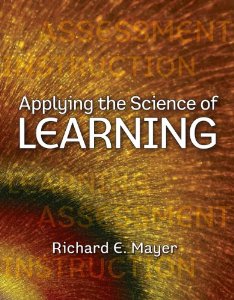By Richard E. Mayer
For this short book (134 pages), Dr. Richard Mayer reviewed and synthesized research findings for the best evidence about learning. He organized the book into three areas: learning, instruction, and assessment.
He starts with the most basic explanations, like “What is learning?” and “Why is it important to apply the science of learning?” From there, he reviews what we can use from the research in understandable prose. (He includes cognitive psychology terms, but explains each one.)
Learning. To paraphrase, ‘Learning is a change in knowledge that is caused by a learner’s experience.’ Mayer reviews many of the key ideas in learning, including: transfer, how learning works, the effects of practice and time after learning, active processing, memory, motivation, and metacognition (learners’ awareness, monitoring, and control of their own learning).
Instruction. As we try to foster learning, we offer experiences to the learners and we intend to improve their knowledge. In this section, Mayer reviews instructional objectives, types of knowledge, cognitive processes (based on a revision of Bloom’s Taxonomy), ways we create demands on our learners’ cognitive capacity, learner engagement, and guiding instruction via techniques for selecting, organizing, and integrating learning. There are some great principles here for online learning, too. He also provides cautions for popular but questionable principles: collaboration (without sufficient guidance), discovery learning, and learning styles.
Assessment. Before or after instruction, we seek to answer questions about what a learner knows, how they learned something, or about their characteristics related to learning. One of the useful parts of this section gives examples for testing using three levels of transfer: retention, near transfer, and far transfer. There’s also a delightful review of meaningful vs. rote learning. He highlights the importance of prior knowledge as a key difference between learners. At the end of this section is a short list of things that can go wrong with assessment: measuring the wrong variable, using the wrong instrument, and overtesting.
For anyone who is teaching or designing instruction (in the classroom or online), this little book is well worth reading and studying. What works? How do we know? And what are some popular pitfalls we should avoid?
Resources
Book: Applying the Science of Learning
Article: Why Minimal Guidance During Instruction Does Not Work

